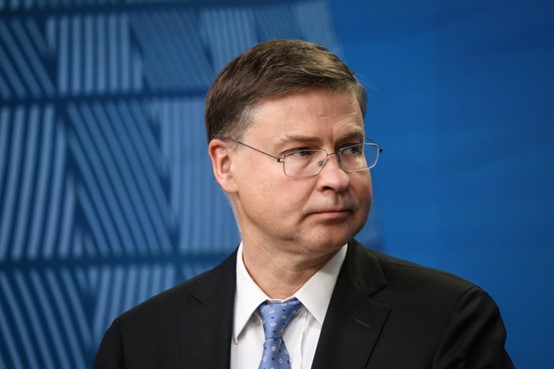 上海生产的特斯拉,将成为欧盟贸易专员瓦尔蒂斯·东布罗夫斯基斯对中国电动汽车反补贴调查的对象。摄影:SIMON WOHLFAHRT —— 彭博社经盖蒂图片社提供
上海生产的特斯拉,将成为欧盟贸易专员瓦尔蒂斯·东布罗夫斯基斯对中国电动汽车反补贴调查的对象。摄影:SIMON WOHLFAHRT —— 彭博社经盖蒂图片社提供当历史学家们回顾电动汽车行业的历史时,他们可能会认为过去一个月是关键转折点,标志着中国崛起为汽车行业的重要参与者。
先是中国的电动汽车厂商在两年一次的慕尼黑车展上,成为媒体报道的焦点,让欧洲的汽车厂商首次在自己的地盘上变成了配角。
几天后,欧盟委员会主席乌尔苏拉·冯德莱恩宣布,将对中国向欧洲出口的电动汽车展开新一轮调查,这加剧了欧盟与中国的紧张关系。欧盟曾认为中国既是合作伙伴,也是竞争对手。
现在,全球最大的电动汽车厂商特斯拉(Tesla),可能因为其在上海的工厂,成为被调查的目标。如果调查认定埃隆·马斯克的公司从中国获得了国家补贴,足以破坏公平竞争,特斯拉将面临惩罚性关税,特斯拉从其旗舰工厂向欧盟出口汽车将在经济上变得不可行。
欧盟贸易专员瓦尔蒂斯·东布罗夫斯基斯在接受《金融时报》采访时表示:“调查并不局限于中国品牌的电动汽车,还会涉及接受生产补贴的其他厂商的汽车。”东布罗夫斯基斯在采访中为调查辩护称,已经掌握了“充足的初步证据”。
特斯拉并未对置评请求作出答复。
这对于一些欧洲品牌的电动汽车而言绝非好消息,例如Polestar 2、BMW ix3和Cupra Tavascan等都在中国生产并用于出口。
但损失最大的可能是特斯拉。特斯拉位于加州弗里蒙特的工厂曾经归通用汽车(GM)和丰田汽车(Toyota)的一家合资公司所有,但上海超级工厂却是特斯拉第一家从零开始建造起来的工厂,从最开始就采用了先进的生产工具。
中国低成本的工人在一个月内可以组装两个车型约80,000辆汽车,因此这座工厂被普遍认为是特斯拉盈利能力最强的工厂,而且由于其庞大的规模,这可能也是全世界效率最高的工厂。该工厂约五分之二的汽车用于出口,其中许多是出口到欧盟单一市场的Model 3。
东布罗夫斯基斯刚刚结束了在中国为期一周的高层会议,他在会上释放了与以往不同的信息。由于中国在俄乌战争中对俄罗斯的支持、惊人的4,000亿欧元贸易赤字以及欧盟对中国稀土、精炼锂和太阳能电池板的战略性依赖,欧盟布鲁塞尔总部流行的一个词是“去风险化”。
鉴于对俄罗斯能源进口的依赖所造成的灾难性后果,政策制定者们正在重新评估欧盟与中国的关系,他们坚持认为欧盟不会与全球第二大经济体脱钩,但会更加直截了当地维护自身利益。
中国的逐底竞争摧毁了欧洲的太阳能产业
通过数据可以看出欧盟电动汽车问题的严重性。德国电动汽车市场分析师马提亚斯·施密特本周写道:“中国汽车制造商生产的汽车在西欧新乘用车登记数量中的占比略低于3%。”
这个比例虽然看起来不高,但这是在一个高度碎片化的汽车市场,而且其中还包括传统燃油车。特斯拉的销量与中国品牌汽车的销量相当,而日产(Nissan)和本田(Honda)等知名品牌的销量均低于这个数字。
中国开辟新市场取得的成功,在英国更加明显。英国是中国电动汽车在欧洲的第一大出口目的地,约有三分之一中国电动汽车被出口到驾驶位在右侧的英国市场。
中国汽车厂商最终涌入欧洲市场所带来的威胁,与最初的日本和后来的韩国汽车厂商进入欧洲市场的模式一样。日韩都是首先发展低端市场,经过数十年后,终于可以与现有汽车品牌相提并论。
中国已经有高度成熟的汽车产业。比亚迪(BYD)、蔚来(Nio)和小鹏(XPeng)等主要品牌出口的车型,没有必要通过低价来获取竞争优势。这些品牌专注于开发由电动动力传动系统驱动、价格实惠的高端汽车,对所有汽车厂商都构成了威胁,包括高端品牌。
冯德莱恩本月在盟情咨文演讲中,将中国快速发展的电动汽车行业带来的威胁,与欧盟在本世纪初的遭遇相提并论。当时,欧盟刚刚起步的太阳能电池板产业,被中国进口的廉价太阳能电池板摧毁。
她为调查辩护称:“我们没有忘记中国不公平的贸易手段对我们的太阳能产业的影响。欧盟对竞争持开放态度,但我们并不欢迎逐底竞争。”(财富中文网)
翻译:刘进龙
审校:汪皓
上海生产的特斯拉,将成为欧盟贸易专员瓦尔蒂斯·东布罗夫斯基斯对中国电动汽车反补贴调查的对象。摄影:SIMON WOHLFAHRT —— 彭博社经盖蒂图片社提供
当历史学家们回顾电动汽车行业的历史时,他们可能会认为过去一个月是关键转折点,标志着中国崛起为汽车行业的重要参与者。
先是中国的电动汽车厂商在两年一次的慕尼黑车展上,成为媒体报道的焦点,让欧洲的汽车厂商首次在自己的地盘上变成了配角。
几天后,欧盟委员会主席乌尔苏拉·冯德莱恩宣布,将对中国向欧洲出口的电动汽车展开新一轮调查,这加剧了欧盟与中国的紧张关系。欧盟曾认为中国既是合作伙伴,也是竞争对手。
现在,全球最大的电动汽车厂商特斯拉(Tesla),可能因为其在上海的工厂,成为被调查的目标。如果调查认定埃隆·马斯克的公司从中国获得了国家补贴,足以破坏公平竞争,特斯拉将面临惩罚性关税,特斯拉从其旗舰工厂向欧盟出口汽车将在经济上变得不可行。
欧盟贸易专员瓦尔蒂斯·东布罗夫斯基斯在接受《金融时报》采访时表示:“调查并不局限于中国品牌的电动汽车,还会涉及接受生产补贴的其他厂商的汽车。”东布罗夫斯基斯在采访中为调查辩护称,已经掌握了“充足的初步证据”。
特斯拉并未对置评请求作出答复。
这对于一些欧洲品牌的电动汽车而言绝非好消息,例如Polestar 2、BMW ix3和Cupra Tavascan等都在中国生产并用于出口。
但损失最大的可能是特斯拉。特斯拉位于加州弗里蒙特的工厂曾经归通用汽车(GM)和丰田汽车(Toyota)的一家合资公司所有,但上海超级工厂却是特斯拉第一家从零开始建造起来的工厂,从最开始就采用了先进的生产工具。
中国低成本的工人在一个月内可以组装两个车型约80,000辆汽车,因此这座工厂被普遍认为是特斯拉盈利能力最强的工厂,而且由于其庞大的规模,这可能也是全世界效率最高的工厂。该工厂约五分之二的汽车用于出口,其中许多是出口到欧盟单一市场的Model 3。
东布罗夫斯基斯刚刚结束了在中国为期一周的高层会议,他在会上释放了与以往不同的信息。由于中国在俄乌战争中对俄罗斯的支持、惊人的4,000亿欧元贸易赤字以及欧盟对中国稀土、精炼锂和太阳能电池板的战略性依赖,欧盟布鲁塞尔总部流行的一个词是“去风险化”。
鉴于对俄罗斯能源进口的依赖所造成的灾难性后果,政策制定者们正在重新评估欧盟与中国的关系,他们坚持认为欧盟不会与全球第二大经济体脱钩,但会更加直截了当地维护自身利益。
中国的逐底竞争摧毁了欧洲的太阳能产业
通过数据可以看出欧盟电动汽车问题的严重性。德国电动汽车市场分析师马提亚斯·施密特本周写道:“中国汽车制造商生产的汽车在西欧新乘用车登记数量中的占比略低于3%。”
这个比例虽然看起来不高,但这是在一个高度碎片化的汽车市场,而且其中还包括传统燃油车。特斯拉的销量与中国品牌汽车的销量相当,而日产(Nissan)和本田(Honda)等知名品牌的销量均低于这个数字。
中国开辟新市场取得的成功,在英国更加明显。英国是中国电动汽车在欧洲的第一大出口目的地,约有三分之一中国电动汽车被出口到驾驶位在右侧的英国市场。
中国汽车厂商最终涌入欧洲市场所带来的威胁,与最初的日本和后来的韩国汽车厂商进入欧洲市场的模式一样。日韩都是首先发展低端市场,经过数十年后,终于可以与现有汽车品牌相提并论。
中国已经有高度成熟的汽车产业。比亚迪(BYD)、蔚来(Nio)和小鹏(XPeng)等主要品牌出口的车型,没有必要通过低价来获取竞争优势。这些品牌专注于开发由电动动力传动系统驱动、价格实惠的高端汽车,对所有汽车厂商都构成了威胁,包括高端品牌。
冯德莱恩本月在盟情咨文演讲中,将中国快速发展的电动汽车行业带来的威胁,与欧盟在本世纪初的遭遇相提并论。当时,欧盟刚刚起步的太阳能电池板产业,被中国进口的廉价太阳能电池板摧毁。
她为调查辩护称:“我们没有忘记中国不公平的贸易手段对我们的太阳能产业的影响。欧盟对竞争持开放态度,但我们并不欢迎逐底竞争。”(财富中文网)
翻译:刘进龙
审校:汪皓
When historians look back on the electric vehicle industry, they may very well point to this past month as the turning point marking China’s emergence as a global player in the auto industry.
First its electric vehicle manufacturers dominated media coverage of Munich’s biennial IAA auto show, relegating Europe’s carmakers to second fiddle on their own home turf for the very first time.
Only days later, EU Commission president Ursula von der Leyen announced China’s EV exports into Europe would be the target of a new investigation, escalating tensions with a country that was once seen just as much as a partner as a rival.
Now Tesla, the world’s largest EV maker largely thanks to its factory in Shanghai, could be drawn into the probe. Were it found to have accepted state subsidies from China that are large enough to have distorted the competitive playing field, Elon Musk’s company may face punitive tariffs that render exports to the EU from its flagship plant economically unviable.
“It’s not limited only to Chinese brand electrical vehicles, it can be also other producers’ vehicles if they are receiving production-side subsidies,” EU Trade Commissioner Valdis Dombrovskis said in an interview with the Financial Times, justifying the investigation by citing “sufficient prima facie evidence”.
Tesla did not respond to a request for comment.
This is potentially unwelcome news for some European brands’ EV models: the Polestar 2, BMW ix3, and Cupra Tavascan are all built exclusively in China for export.
But Tesla may stand to lose the most. Whereas Tesla’s factory in Fremont, Calif., once belonged to a GM-Toyota joint venture, GigaShanghai was its first built from scratch and employing the latest in advanced manufacturing tools from the outset.
Since low-cost Chinese laborers assemble around 80,000 vehicles a month in only two versions, it’s widely believed to be Tesla’s most profitable factory—and potentially the most efficient worldwide due to its sheer scale. Roughly two-fifths of its volume is shipped abroad, many of them Model 3 sedans destined for the EU’s Single Market.
Dombrovskis just concluded a week of high-level meetings in China, where he is sending a different message than in the past. Thanks to China’s support for Russia in the Ukraine war, a yawning €400 billion trade deficit, and a strategic dependence on Beijing for rare earths, refined lithium, and solar cells, the buzzword around Brussels is “de-risking.”
Policymakers are reassessing the EU’s relationship with China through the lens of its disastrous dependence on Vladimir Putin for the bulk of its energy imports, insisting they won’t decouple from the world’s second largest economy but be more forthright in asserting its interests.
China’s race to the bottom destroyed the European solar industry
The scale of the EV problem becomes clear when one looks at the data. “Chinese auto manufacturers accounted for just under 3% of western Europe’s new passenger car registrations,” wrote Germany-based EV market analyst Matthias Schmidt this week.
That may seem like very little, but that is out of a highly fragmented auto market, combustion engine cars included. Tesla also sells roughly that number, and well-known brands like Nissan and Honda fall short of that mark.
The success of China moving into new markets is even more apparent in the U.K. It tops the list of European destinations for Chinese EVs, with almost one-third exported to the right-hand-drive market, according to Schmidt.
The threat of Chinese carmakers eventually flooding Europe’s market has long been based on the pattern established first by Japan and later South Korea. Both started out in the low-end market and needed decades before finally being perceived as on par with incumbent players.
China already has a highly mature auto industry with major brands like BYD, Nio and XPeng now exporting models that have no need to compete for the bottom dollar. Their focus on affordable high-tech cars powered by electric drivetrains make them a threat for every automaker, premium brands included.
In her State of the Union address this month, Von der Leyen likened the threat from China’s rapidly growing EV industry to Europe’s experience during the aughts, when its burgeoning solar cell industry was crushed by cheap imports from China.
“We have not forgotten how China’s unfair trade practices affected our solar industry,” she said, justifying the probe. “Europe is open for competition. Not for a race to the bottom.“






